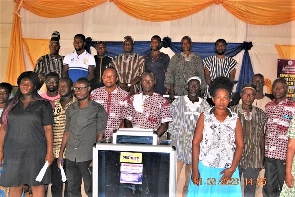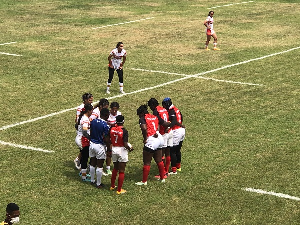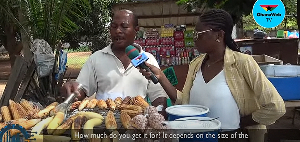The Development Research and Advocacy Centre (DRAC) and the Ghana Coalition of NGOs in Health (GCNH) have jointly launched a project to combat skin Neglected Tropical Diseases (NTDs) in the Upper East Region. The two-year project, funded by ANESVAD Foundation and dubbed “Strengthening and Building Capacity to Combat Skin NTDs in Ghana”, was launched on Friday in the Bongo District.
“The choice of Bongo for the launch of this important project was no accident. When we started the preparatory meeting for the launch of this project, we from the civil society organisation (CSO) fraternity did not actually have a particular place in mind for the launch.
“But as professionals will always have better eyes of spotting a challenge sitting afar, the [Upper East] Regional Disease Control Officer said, Guys, if this launch is to give us the desired impact, it is important to have it in a district with a relatively endemic situation. So, why don’t you give me a
little time to figure out the place?’ So, we waited and, then, in a few days, he got back with the suggestion we have the launch here in Bongo,” said DRAC’s Director of Programmes, Milton Aberinga, in a speech delivered at the event.
While delivering his speech, Aberinga listed a number of neglected tropical diseases he said had become endemic in Ghana. He cited lymphatic filariasis (elephantiasis), onchocerciasis, trachoma, schistosomiasis, soil transmitted helminthiasis, buruli ulcer and yaws. He also mentioned leprosy, guinea worm, Human African Trypanosomiasis (HAT), cutaneous leishmaniasis and rabies. But he
said the ones the Upper East Region was struggling with among the diseases were leprosy, elephantiasis and yaws.
According to the Director of Programmes, efforts being made to control the diseases are yielding no results owing to such factors as limited funding, inadequate human resource capacity, stigma, knowledge gaps, cultural norms and tradition among others.
“Stigma associated with certain disease conditions tend to affect how people affected by such diseases are accepted and supported in rural communities especially where cultural practices are ingrained as lifestyles. High levels of stigma are associated with NTDs endemic in some districts in the Upper East Region.
“This results in poor access to health services. However, the right to health is a constitutional right and Ghana has ratified several global-level instruments and accords promoting the value of health and the right to health for all Ghanaians. It is, therefore, important that awareness of the right to access health services be increased for beneficiaries to begin to demand more from duty bearers for health,” he stated.
Project to be implemented in five districts
DRAC and GCNH are set to carry out the project in five districts in the Upper East Region. The areas include Binduri, Bongo, Builsa South, Nabdam and Talensi.
An organisation has been engaged to implement the project in partnership with DRAC and GCNH in each of the districts. They are Women Integrated Development and Education Centre (WIDEC) in Binduri, Integrated Youth Needs and Welfare (INTYON) in Nabdam, Kunkua Renaissance Development Centre (KURADEC) in Bongo, Rural Underprivileged Youth (RUPY) in Talensi and Akanyue Foundation in Builsa South.
Key among the objectives of the project are: to help reduce deaths associated with skin NTDs; to strengthen the healthcare system towards the integration of skin NTDs with other programmes particularly at the primary healthcare level; to advocate for the inclusion of skin NTDs into the National Health Insurance Scheme (NHIS) covering both registration and treatment costs; to improve
the knowledge level of healthcare staff on Intensified and Innovative Disease Management (IIDM) and to improve the surveillance, reporting and referrals of skin NTDs patients.
The project is also aimed at advocating for the inclusion of skin NTDs in the NHIS and Disability funds, for the inclusion of Water, Sanitation and Hygiene (WASH) in the mid-term plans and budgets of district assemblies’ community sensitisation activities on WASH and for the inclusion of skin NTDs in local health authorities' planning and budgeting.
DRAC and GCNH are also slated to organise training programmes for health staff on skin NTDs as well as surveillance, referrals, reporting and management. Skin NTDs are neglected because they generally affect only poor people, expert sharing the situation of skin NTDs in the region with participants, the Upper East Regional Leprosy Coordinator, Eric Dakura, observed that the diseases were neglected because those affected mostly were the ordinary members of society.
“Other reasons why these diseases are neglected include lack of political voice, lack of visibility, low mortality and low risk perception. These diseases will never appear at the Presidency. They will never get close to the Ministry of Food and Agriculture and the like.
“These diseases are prevalent because much attention has not been given to them because it affects the poor. People who can hardly make ends meet, people who are not decision makers, they are the people these diseases affect. Those are the reasons the diseases are neglected by policy makers, health authorities, health professionals, general population as well as families and relations,” he
pointed out.
He said 31 new leprosy cases were detected in 2020, 33 new cases in 2021 and 34 in 2022 in the region. In 2022, Bongo District recorded 9 new leprosy cases. That was the highest number of new leprosy cases detected that year in the region. Builsa South District and Kassena-Nankana Municipality recorded 6 new cases each. Builsa North Municipality and Kassena-Nankana West District documented 3 new leprosy cases each.
The same year saw 2 cases recorded in Pusiga, Talensi and Tempane districts apiece. One new case was recorded in Bolgatanga Municipality that year. The other areas― Bawku Municipality, Bawku West District, Binduri District, Garu District, Nabdam District and Bolgatanga East District― did not record any new cases that year.
Although the trend of yaws cases in the region has shown an almost-consistent decline since 2016 when 357 cases were reported, of concern to participants at the event was the presence of the contagious disease across the region. In 2017, 117 yaws cases were recorded in the region while 180, 54, 55, 68 and 46 cases were reported in 2018, 2019, 2020, 2021 and 2022 respectively.
A total of 2,373 elephantiasis cases were recorded in the region in 2022 while 1,315 cases of hydrocele (a type of swelling in the scrotum) were reported in the same year in the region. A number of challenges, according to the regional leprosy coordinator, accounted for the presence and spread of skin NTDs in the region. He listed late reporting of cases, inadequate knowledge about skin NTDs, systemic poor prevention and management of disability, dwindling resources for
prevention and management of the diseases and late detection among others.
Declaring the project launched, Esther Mbilla, a public health nurse who represented the Bongo District Health Directorate at the event, said worm infestation, too, had become endemic in Bongo in addition to leprosy, yaws and elephantiasis. She urged all stakeholders to help not only in curbing the spread of the skin NTDs but also in eradicating them by intensifying surveillance and taking advantage of early diagnosis and treatment programmes organised by the Ghana Health Service (GHS) in the district.
The Chief of Anafobiisi-Bongo, Naba Anyanebah Akolgo Saabo II, chaired the event, placing an emphasis on the need for the five districts, where the project is scheduled to be undertaken on a pilot basis, to cooperate with its executors.
“What is important now is for us to encourage them and not to discourage them, or make them regret choosing to work in the districts. I would like to caution participants that one of the reasons programmes may fail is time. Time, as we all know, is the bedrock of the success of every programme.
“You cannot succeed if you work without timelines or planning. In planning, you need to manage your time well to enable you to accomplish every important activity. I would, therefore, wish to plead with participants that we begin to see time management as key in all our endeavours,” he said.
Regional News of Monday, 3 April 2023
Source: www.ghanaweb.com

















